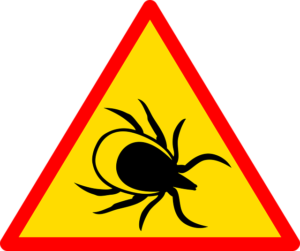
Now that it is spring we need to talk about flea and tick products. This year we had a disappointing snow fall (if you like to ski), but that meant that the ticks have been active for a longer time. Most ticks will stay active as long as the temperature is above freezing, but when it becomes too cold they will hibernate and wait for their next meal to walk on by. Ticks are able to find micro-climates, these are places where pockets of warm air are trapped between the snow, leaves and ground. The female tick will wait until the spring and boy are they hungry. Fleas, on the other hand, can stop their reproduction and wait. Fleas will sense increasing levels of carbon dioxide (think about when you exhale) or movement (think about walking across a carpet where no one has been for a while), and then resume reproduction. So the key to control is to start a little earlier than the fleas and ticks. In this month’s article we would like to address the different flea and tick control products. As always, please address specific questions about your particular needs and your pets medical condition to the Hopewell Animal Hospital.
The first consideration when looking at flea and tick preventatives is the method of delivery. There are 3 main methods of providing protection to your pet- house and yard sprays are a totally different topic that we won’t address here.
The first method is the old tried and true topical medication. The main players in this group are Frontline and Advantix, however t here are now many generics to fipronil, the active ingredient in Frontline. These products use a chemical and a vehicle to deliver the pesticide under the skin where it may become deposited in the fat. As the dog or cat moves around the product is moved, several products use a surfactant to move the chemical along the surface of skin. Topical products have the benefit of being readily available, think grocery store, feed store, Amazon etc., but they have several negative features. The first is because of the way they work, they are usually supplied in an oil base, this oil will leave a greasy spot on your pet for several days to a week, there is one product called Revolution that will kill fleas but not ticks that is in an alcohol vehicle, this will evaporate quickly but is a prescription product.
here are now many generics to fipronil, the active ingredient in Frontline. These products use a chemical and a vehicle to deliver the pesticide under the skin where it may become deposited in the fat. As the dog or cat moves around the product is moved, several products use a surfactant to move the chemical along the surface of skin. Topical products have the benefit of being readily available, think grocery store, feed store, Amazon etc., but they have several negative features. The first is because of the way they work, they are usually supplied in an oil base, this oil will leave a greasy spot on your pet for several days to a week, there is one product called Revolution that will kill fleas but not ticks that is in an alcohol vehicle, this will evaporate quickly but is a prescription product.
Additionally, when handling these products, you should wear gloves to limit your exposure to the product and you should not handle your pet for 24-48 hours after application. Now one of the biggest problems with these products is that people don’t limit their exposure to the chemicals and then become exposed to them. A study from 2015 showed a significant amount of fipronil in the blood of people exposed to the product. A study from 2002 that looked at people exposed to dogs that had fipronil applied. They looked at people who pet their dogs for 5 minutes at weekly intervals for 5 weeks post application. This study showed the highest concentration at 24 hours and found undetectable levels at 5 weeks. Their conclusion was that repeated exposure can pose human health risks.
An additional issue with topical products is environmental contamination. In a large study in the UK, 20 English Rivers were found to have high levels of fipronil and imidacloprid (Advantix). These chemicals can kill tiny aquatic insects which are a crucial food source for fish and birds. Additional studies in San Francisco Bay water treatments plants, levels of both fipronil and imidacloprid routinely exceed toxicity values for aquatic invertebrates.
The last major issue with topical flea and tick products is a possible allergic/sensitivity reaction to the topical product itself. We have seen many pets with reactions to topical products resulting in pain, hair loss and localized infections. Some pets (<1%) may have a sensation of the product “spreading” over their body which feels likes “pins and needles”.
Our next option are collars. There are several collars available, most do not work very well in studies performed. Over the years many types of collars that did work have been removed from the market due to the toxic chemical chlorpyrifos. This chemical has been banned in the United States do to its toxicity. Currently, the Seresto (flumethrin and imidocloprid) collar is the most popular and is very effective, approximately 90% at 5 months. However, if your pet spends any time in the water the effectiveness is shorter and lower. The collar has the benefit that you can apply it and not worry about it for 6-7 months.
The collars can have several problems including loss of the product, if your dog is running out in the woods the collars can break and you have to replace the collar – an additional expense. We have had several dogs that have experienced localized reactions at the site of the collar, most have been treated with topical medications and removal of the collar. Recently, there have been some studies showing an increased resistance in tick populations to deltamethrin. We are closely monitoring the situation in the Hudson Valley. There has recently been a great deal of controversy over the Seresto collar including a congressional hearing. The bottom line is that the monitoring of side effects is not very robust as these collars are regulated by the EPA and not the FDA. Earlier this year, the EPA has signaled that they do not want to be involved with regulating topical and collar flea and tick products. The government is still trying to figure out how this will affect access to these products.
The last and newest type of medication for flea and tick control are the oral medications. These products have been around for about 12 years and have proven very effective at controlling fleas and ticks. One benefit is that these are oral medications, there are no residues to affect you or your family, there is also no run off to affect the environment. This class of medications is by prescription only, therefore it is regulated by the FDA and there have been studies about the safety of these products. Studies have shown effectiveness of over 94% at day 28. So these products seem great right? Well not so fast, there are a few concerns about this entire class of product (this means any ingestible flea and tick product) – one concern is seizures or tremors. In fact, the FDA sent out an advisory notice to veterinarians regarding this class of medications. The report reminds us that isoxazoline products have been associated with neurological adverse reactions, including muscle tremors, ataxia (weakness), and seizures in some dogs. These reactions can occur in animals without a prior history of neurological problems.
Another concern is taste. Some of these products are not very tasty, certainly a minor problem, but one to be aware of.
So the world of flea and tick control is very complicated and is always changing. Please do not hesitate to contact Hopewell Animal Hospital for recommendations concerning YOUR pet. Additionally, we have many money saving offers on most products. So enjoy the upcoming spring, get outside with your pets and have fun, but don’t forget to be safe!!
*** An update to the Seresto Collar (June 28, 2022).
Recently, the United States House of Representatives convened a subcommittee meeting to examine complaints about the Seresto collar. To date, about 100,ooo complaints have been received about the collar with 2,000 alleged deaths reported. The EPA does note an increase in deaths since 2015. The Canadian equivalent of the EPA has banned the collars. The E.U. and Australia EPA both require more warnings on the collars about safety. The House committee did recommend a full investigation and voluntary recall of the collars.
As of this time, the reports are sporadic and make up a small amount of product sales of Seresto Collars. It is still not clear if the reported deaths can be directly linked to the collar or the chemical in the collar. In fact, many questions still remain.
To try to protect our patients and clients, Hopewell Animal Hospital has decided to stop offering the collars in our office and will advise against the use of the Seresto c0llar until more information is available.
